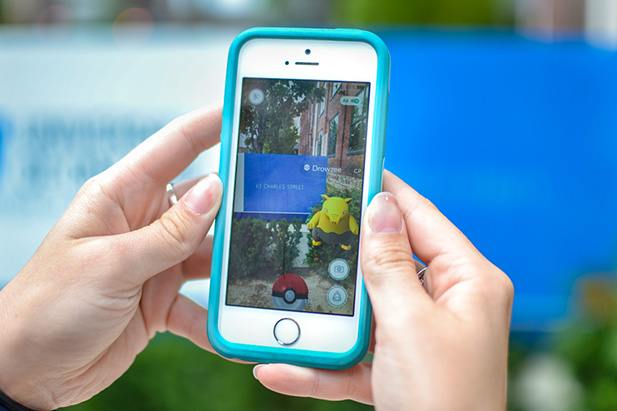Pokémon appear on UOIT campus; researchers share their perspectives
July 22, 2016

Since Pokémon Go officially launched in Canada on July 17, colourful little fictional creatures called Pokémon have been popping up on the smartphones of game-players, both young and old. It doesn’t take long to spot players; they’re the ones staring down at their phones as they walk around, visiting physical locations in the hopes of virtual-capturing one of these critters. Some Pokémon have even appeared on campus at the University of Ontario Institute of Technology (UOIT).
What’s behind the obsession?
According to game development researcher Dr. Andrew Hogue, there are a number of reasons behind the wild popularity of Pokémon Go, the latest in the Pokémon series of games developed jointly by consumer electronics giant Nintendo and Niantic, a mobile game developer.
“The game seems to have connected with game-players due to its novelty in using location-based gameplay mechanics,” explains Dr. Hogue, Program Director and Associate Professor, Game Development and Entrepreneurship, Faculty of Business and Information Technology. “The fact that Pokémon characters now straddle between the purely virtual world and the real world adds to the appeal.”
The game is based on augmented reality technology: the superimposition of digital elements onto user’s view of the real world to create a new hybrid, interactive environment. GPS technology on the player’s phone detects where and when the user is playing the game. The phone displays the player’s avatar (digital character) over top of a digital representation of the player’s real-time surroundings, and makes Pokémon characters appear in the user’s virtual environment. The goal is to visit physical places so you can find Pokémon and ‘catch’ them by throwing virtual balls at them. You can also physically visit Pokéstops–public landmarks like malls, parks or restaurants–where you collect these virtual balls, as well as other items needed for the game.
Familiarity with the well-known Pokémon universe and nostalgia for the franchise’s original games of the 1990s are also behind the game’s success.
“Pokémon has been around in a variety of forms–including collector card battles and video games–for many years,” Dr. Hogue adds. “Players who grew up with these games have fond memories of the gameplay with friends, which makes this new game strike a chord with this demographic.”
What’s so special about the Pokémon Go experience?

Dr. Isabel Pedersen, Canada Research Chair in Digital Life, Media and Culture, and Director of Decimal: Digital Culture and Media Lab researches the intersection of technology and society. She sees Pokémon Go as an example of how augmented reality can open up more opportunities for social interaction.
“Pokémon Go gets people out of their chairs and into the real world playing a cool and compelling game,” she says. “It brings together people in unexpected ways. Augmented reality isn’t a new media; it has been used for decades in museums, art installations and even manufacturing, but this is the first time a large and established company, Nintendo, has put its weight behind it. Augmented reality is now available for consumers. People are amazed they can have the technology on their own phones, which have finally evolved enough to support augmented reality properly.”
“Pokémon Go pulls video gameplay out of the TV sets and computer screens of private homes and pushes interactive storytelling into the public places and mobile devices of everyday life,” adds Dr. Tanner Mirrlees, Decimal Lab Associate and Assistant Professor, Communication and Digital Media Studies in the university’s Faculty of Social Science and Humanities. “By turning our communities, parks, streets and sidewalks into real settings for virtual play, the game merges actual places with fictional spaces. It is like a massive multiplayer online role playing game has been superimposed on our neighborhoods.”
The game’s pros and cons
Dr. Pedersen cautions players to be aware of the implications related to personal information protection. “Any third-party app that knows your location and your profile information is something we have to be wary of, and realize there is a loss of privacy.”
Dr. Hogue acknowledges Pokémon Go can be distracting. “Players can easily get caught up in trying to find new Pokémon, causing them to walk around while fixating on their phones,” he says. “While this is great since it encourages physical exercise, it can cause players to run into walls, fall down stairs, or worse if they are not aware of their physical surroundings.” However, he notes the game consistently warns players to be aware of their surroundings while playing.
On the upside, the game can be commended for encouraging social interaction.
“While the game does have an optional competitive element to its gameplay (battling each other’s Pokémon in Gyms), much of the gameplay is about finding and catching Pokémon, which seems to have developed a social aspect to it as players tend to walk around in groups searching for Pokémon,” Dr. Hogue adds. “The game doesn’t specifically encourage social behaviour, but it seems as though the collaboration that emerges makes the game more fun and interesting.”



